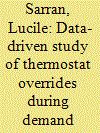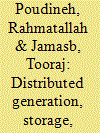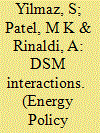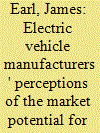|
|
|
Sort Order |
|
|
|
Items / Page
|
|
|
|
|
|
|
| Srl | Item |
| 1 |
ID:
150904


|
|
|
|
|
| Summary/Abstract |
Peak reduction is an important problem in the context of the electricity grid and has led to conservation programs in various jurisdictions. For example, in Ontario, Canada, residential customers are charged higher prices during peak times, while large industrial and commercial customers pay heavy surcharges that depend on their load during Ontario’s five peak-demand days. Reducing these surcharges is a challenging problem for large consumers due to the difficulty of predicting peak days in advance.
We study the impact of this peak reduction program, called 5 Coincident Peaks (5CP), on consumers by analyzing the difficulty of predicting peak-demand days and peak hours on those days. We find that even the state-of-the art peak-prediction algorithms require consumers to curtail load ten or more times, and even then, they may not identify all five peak-demand days. We also analyze alternative policies that cold help reduce peak demand in Ontario.
|
|
|
|
|
|
|
|
|
|
|
|
|
|
|
|
| 2 |
ID:
177113


|
|
|
|
|
| Summary/Abstract |
Although numerous studies have examined the economic benefits of demand response programs, the environmental impacts of such programs have been relatively underexplored. This study assesses the impact of demand resource bidding on the wholesale energy market and the environment, based on three years of high temporal-resolution data from Korea. In this demand resource bidding program, successful bidders were paid the system marginal price for reducing their electrical load at a given hour, which in turn reduced the generation of power from various technologies. This investigation of how carbon dioxide and particulate matter emissions from existing power systems changed with the introduction of the demand bidding program finds that the program altered the system operator's electricity generation portfolio and marginally abated carbon dioxide and particulate matter emissions from the power sector. It also shows that the environmental impact of the program varied over the course of the day and the year. The modest but statistically significant environmental impact of the demand resource bidding program points to the importance of including electricity demand resources in the discussion and development of energy and environmental policies for the power sector.
|
|
|
|
|
|
|
|
|
|
|
|
|
|
|
|
| 3 |
ID:
125810


|
|
|
|
|
| Publication |
2013.
|
| Summary/Abstract |
An impact of increased variable renewable generation is the need for balancing authorities to procure more ancillary services. While demand response resources are technically capable of providing these services, current experience across the U.S. illustrates they are relatively minor players in most regions. Accessing demand response resources for ancillary services may require a number of changes to policies and common practices at multiple levels. Regional reliability councils must first define ancillary services such that demand response resources may provide them. Once the opportunity exists, balancing authorities define and promulgate rules that set the infrastructure investments and performance attributes of a resource wishing to provide such services. These rules also dictate expected revenue streams which reveal the cost effectiveness of these resources. The regulatory compact between utility and state regulators, along with other statutes and decisions by state policymakers, may impact the interest of demand response program providers to pursue these resources as ancillary service providers. This paper identifies within these broad categories specific market and policy barriers to demand response providing ancillary services in different wholesale and retail environments, with emphasis on smaller customers who must be aggregated through a program provider to meet minimum size requirements for wholesale transactions.
|
|
|
|
|
|
|
|
|
|
|
|
|
|
|
|
| 4 |
ID:
115140


|
|
|
|
|
| Publication |
2012.
|
| Summary/Abstract |
The penetration of wind and solar generating resources is expected to dramatically increase in the United States over the coming years. It is widely understood that large scale deployment of these types of renewable energy sources (e.g., wind, solar) that have variable and less predictable production characteristics than traditional thermal resources poses integration challenges for bulk power system operators. At present, bulk power system operators primarily utilize strategies that rely on existing thermal generation resources and improved wind and solar energy production forecasts to manage this uncertainty; a host of additional options are also envisioned for the near future including demand response (DR). There are well-established bodies of research that examine variable generation integration issues as well as demand response potential; but, the existing literature that provides a comparative assessment of the two neither treats this topic comprehensively nor in a highly integrated fashion. Thus, this paper seeks to address these missing pieces by considering the full range of opportunities and challenges for mass market DR rates and programs to support integration of variable renewable generation.
|
|
|
|
|
|
|
|
|
|
|
|
|
|
|
|
| 5 |
ID:
150068


|
|
|
|
|
| Summary/Abstract |
Electricity sector has been transformed from state-owned monopolistic utilities to competitive markets with an aim to promote incentives for improving efficiency, reducing costs and increasing service quality to customers. One of the cardinal assumptions of the liberalized and competitive electricity markets is the rational actor, and decision-makers are assumed to make the best decisions that maximize their utility. However, a vast literature on behavioral economics has shown the weakness of economic theory in explaining and predicting individuals’ decision-making behavior. This issue is quite important for competition in electricity markets in which consumers’ preferences have a significant role. Despite its importance, this issue has almost been neglected in Turkey, which has taken major steps in electricity sector restructuring. Therefore, this paper aims to examine switching and demand response behavior in Turkish electricity market by using multiple correspondence and panel data analysis, and findings are discussed in light of the neoclassical and behavioral economics literature. Analyses’ results show that consumers’ switching and demand response behavior is consistent with the neoclassical literature to some extent; however, behavioral factors are also affecting consumers’ decisions. Furthermore, there are systemic problems that hinder effective functioning of the electricity market and restrict competition.
|
|
|
|
|
|
|
|
|
|
|
|
|
|
|
|
| 6 |
ID:
188559


|
|
|
|
|
| Summary/Abstract |
Load management is the practice of adjusting demand in an electricity system through remote control of—or incentives to operate—grid-edge technologies in alignment with system goals. Although load management functions as a distributed energy resource (DER) and can play a critical role in cost-effective deployment of renewable energy toward economy-wide deep decarbonization, there has been little energy transitions research on how electric grid actors initiate and manage DER deployments over time. We use interviews and archival research to compare case studies of electric cooperatives in the United States, tracing how cooperatives deployed more than 600,000 load management devices over 70 years. Using polycentricism as a frame, we find that DER deployments comprise common pool resources that are strategically created and negotiated across scales by different centers of decision-making over time. Our findings rebut the assumption that DER deployments are solely the result of policies or markets, showing that DER deployments are instead polycentric acts of cooperation and competition. DER deployments require diverse intermediaries within and across levels of deployment, from policy to users, over many years. We show that polycentric governance that builds vertical coordination across local and regional actors can support broad, deep, and distributed energy transition.
|
|
|
|
|
|
|
|
|
|
|
|
|
|
|
|
| 7 |
ID:
178813


|
|
|
|
|
| Summary/Abstract |
In the context of increasing renewable energy penetration in energy systems, demand response is acknowledged as a solution to guarantee grid stability and security of supply. Direct control of appliances by utilities, however, may lead to user dissatisfaction and disengagement via overrides. The present study, based on data from 6,389 connected thermostats in North America in the summer of 2019, investigates users' thermostat overriding behavior during demand response events targeting their air conditioners. An average event in this dataset was triggered around 3 p.m. and lasted three hours. The overall override rate was 12.9%. Overrides critically affected power usage during an event, with the share of the expected power demand reduction missed due to overrides being of the same order of magnitude as the override rate. In a decision tree analysis, the override rate showed to be particularly affected by occupants' habitual setpoint change frequency, outdoor temperature, event duration, and occupants’ previous experience with demand response. Even though the dataset is not representative of all types of demand response events, this study highlights the potential lying in connected thermostat data for utilities to design tailored demand response events with an increased success rate and a smaller impact on occupant comfort.
|
|
|
|
|
|
|
|
|
|
|
|
|
|
|
|
| 8 |
ID:
177508


|
|
|
|
|
| Summary/Abstract |
Energy transitions change the relationships between technologies and human actors. Demand response (DR), the matching of demand to available electricity supply, is a relatively new activity, important for systems that rely on distributed renewable generation. Price-based DR is spreading among residential and small business customers, along with direct control of distributed and aggregated small loads, mostly thermal. In both types of DR, information and communication technology plays a part.
|
|
|
|
|
|
|
|
|
|
|
|
|
|
|
|
| 9 |
ID:
125529


|
|
|
|
|
| Publication |
2013.
|
| Summary/Abstract |
Demand response is believed by some to become a major contributor towards system balancing in future electricity networks. Shifting or reducing demand at critical moments can reduce the need for generation capacity, help with the integration of renewables, support more efficient system operation and thereby potentially lead to cost and carbon reductions for the entire energy system.
In this paper we review the nature of the response resource of consumers from different non-domestic sectors in the UK, based on extensive half hourly demand profiles and observed demand responses. We further explore the potential to increase the demand response capacity through changes in the regulatory and market environment.
The analysis suggests that present demand response measures tend to stimulate stand-by generation capacity in preference to load shifting and we propose that extended response times may favour load based demand response, especially in sectors with significant thermal loads.
|
|
|
|
|
|
|
|
|
|
|
|
|
|
|
|
| 10 |
ID:
116707


|
|
|
|
|
| Publication |
2012.
|
| Summary/Abstract |
This paper outlines a methodology for implementing cost of service regulation in retail market for electricity in India when wholesale market is liberalised and operates through an hourly spot market. As in a developing country context political considerations make tariff levels more important than supply security, satisfying the earmarked level of demand takes a back seat. Retail market regulators are often forced by politicians to keep the retail tariff at suboptimal level. This imposes budget constraint on distribution companies to procure electricity that it requires to meet the earmarked level of demand. This is the way demand response is introduced in the system and has its impact on spot market prices. We model such a situation of not being able to serve the earmarked demand as disutility to the regulator which has to be minimised and we compute associated equilibrium. This results in systematic mechanism for cutting loads. We find that even a small cut in ability of the distribution companies to procure electricity from the spot market has profound impact on the prices in the spot market.
|
|
|
|
|
|
|
|
|
|
|
|
|
|
|
|
| 11 |
ID:
128363


|
|
|
|
|
| Publication |
2014.
|
| Summary/Abstract |
Electricity production from centralised and decentralised renewable energy resources in Europe is gaining significance, resulting in operational challenges in the electricity system. Although these challenges add to the locational and time dependency of the underlying cost of operating the system, this variability in time and location is not reflected in residential tariff schemes. Consequently, residential users are not incentivised to react to varying system conditions and to help the integration of renewable energy resources. Therefore, this paper provides a theoretical framework for designing a locational dynamic pricing scheme. This can be used to assess existing tariff structures for consumption and injection, and can serve as a theoretical background for developing new tariff schemes. Starting from the underlying costs, this paper shows that the potential for locational dynamic pricing depends on the locational and time dependency of its cost drivers. When converting costs into tariffs, the tariff design should be determined. This includes the advance notice of sending tariffs to users, and the length of price blocks and price patterns. This tariff design should find a balance between tariff principles related to costs, practicality and social acceptability on the one hand, and the resulting demand response incentive on the other.
|
|
|
|
|
|
|
|
|
|
|
|
|
|
|
|
| 12 |
ID:
090076


|
|
|
|
|
| Publication |
2009.
|
| Summary/Abstract |
In Norway there is a growing concern that electricity production and transmission may not meet the demand in peak-load situations. It is therefore important to evaluate the potential of different demand-side measures that may contribute to reduce peak load. This paper analyses data from an experiment where residential water heaters were automatically disconnected during peak periods of the day. A model of hourly electricity consumption is used to evaluate the effects on the load of the disconnections. The results indicate an average consumption reduction per household of approximately 0.5 kWh/h during disconnection, and an additional average increase in consumption the following hour, due to the payback effect, that may reach up to 0.28 kWh/h per household.
|
|
|
|
|
|
|
|
|
|
|
|
|
|
|
|
| 13 |
ID:
111450


|
|
|
|
|
| Publication |
2012.
|
| Summary/Abstract |
Although the benefits of distributed cogeneration are widely cited, adoption has been slow in the United States. Adoption could be encouraged by making cogeneration more economically attractive, either by increasing the expected returns or decreasing the risks of such investments. We evaluate the expected returns from demand response, capacity markets, regulation markets, accelerated depreciation, pricing CO2 emissions, and net metering. We find that (1) there is an incentive to overcommit in the capacity market due to lenient non-response penalties, (2) there is significant revenue potential in the regulation market, though demand-side resources are yet to participate, (3) a price on CO2 emissions will make cogeneration more attractive relative to conventional, utility-supplied energy, and (4) accelerated depreciation is an easy and effective mechanism for improving the economics of cogeneration. We go on to argue that uncertainty in fuel and electricity prices present a significant risk to cogeneration projects, and we evaluate the effectiveness of feed-in tariffs at mitigating these risks. We find that guaranteeing a fixed electricity payment is not effective. A two-part feed-in tariff, with an annual capacity payment and an energy payment that adjusts with fuel costs, can eliminate energy-price risks.
|
|
|
|
|
|
|
|
|
|
|
|
|
|
|
|
| 14 |
ID:
128352


|
|
|
|
|
| Publication |
2014.
|
| Summary/Abstract |
The need for investment in capital intensive electricity networks is on the rise in many countries. A major advantage of distributed resources is their potential for deferring investments in distribution network capacity. However, utilizing the full benefits of these resources requires addressing several technical, economic and regulatory challenges. A significant barrier pertains to the lack of an efficient market mechanism that enables this concept and also is consistent with business model of distribution companies under an unbundled power sector paradigm. This paper proposes a market-oriented approach termed as "contract for deferral scheme" (CDS). The scheme outlines how an economically efficient portfolio of distributed generation, storage, demand response and energy efficiency can be integrated as network resources to reduce the need for grid capacity and defer demand driven network investments.
|
|
|
|
|
|
|
|
|
|
|
|
|
|
|
|
| 15 |
ID:
176652


|
|
|
|
|
| Summary/Abstract |
To date, research has mostly focused on the impact of energy efficiency on the total electricity demand but not on the electricity demand profiles. To address this gap, we estimate the impact of energy efficiency measures and policies such as minimum energy performance standards on the peak load by developing a bottom-up model that generates Swiss household hourly electricity demand profiles per appliance based on time use data. The model estimates that evening appliance peak demand can be reduced by 38% when the appliances are replaced by the highest energy efficiency label available on market. We find that changing light bulbs to LED would have the same peak reduction as switching cooking or wet appliances to off-peak periods throughout the year. We also show that the evening appliance peak demand could reduce in 2035 by 24% thanks to the improvement of the energy performance of the stock. Cooking appliances, the least favourable appliances to be involved in demand response, is expected to be the highest contributors to the evening peak in 2035. Our findings show that policy makers should pay due attention to energy efficiency improvement not only for reducing electricity demand but also in order to reduce peak load.
|
|
|
|
|
|
|
|
|
|
|
|
|
|
|
|
| 16 |
ID:
124376


|
|
|
|
|
| Publication |
2013.
|
| Summary/Abstract |
The aim of this paper is to show the economic potential of demand response (DR) on household level at Central European market conditions. Thereby, required economic benefits for consumers' participation, the realistic load shifting potential at household level and the estimation of essential intelligent infrastructure costs are discussed. The core of this paper builds a case-study applying spot market-oriented load shifting from the supplier's point of view by using Austrian electricity market data, household load profiles as well as a heat pump and e-car charging load profile. It is demonstrated which cost savings for suppliers can be derived from such load shifting procedure at household level. Furthermore, upper cost limits for intelligent infrastructure in order to break-even are derived. Results suggest to take a critical look at European discussions on DR implementation on household level, showing that at Central European market conditions the potential for DR at household level is restricted to significant loads and hence, the applied load shifting strategy is only beneficial with application to heat pumps. In contrast, the frequently discussed shifting of conventional household devices' loads (such as washing machines) economically does not add up.
|
|
|
|
|
|
|
|
|
|
|
|
|
|
|
|
| 17 |
ID:
150652


|
|
|
|
|
| Summary/Abstract |
Participation in demand response (DR) may affect a consumer's electric consumption pattern through consumption load curtailment, a shift in the consumption timing or increasing the utilization of distributed generation (DG). This paper attempts to provide empirical evidence of DR's effect on DG adoption by household consumers. By using the original Internet survey data of 5442 household respondents in Japan conducted in January 2015, we focus on the effect of the time-of-use (TOU) tariff on the purchasing intention of photovoltaic systems (PV). The empirical results show the following: 1) current TOU plan users have stronger PV purchase intentions than the other plan users, 2) respondents who are familiar with the DR program have relatively higher purchase intentions compared with their counterparts, and 3) when the respondents are requested to assume participation in the virtual TOU plan designed for the survey, which resembles plans currently available through major companies, 1.2% of the households have decided to purchase PV. In addition, we provide calculations of TOU's impacts on the official PV adoption and emissions reduction targets, and discuss policy recommendations to increase recognitions and participations in TOU programs.
|
|
|
|
|
|
|
|
|
|
|
|
|
|
|
|
| 18 |
ID:
096635


|
|
|
|
|
| Publication |
2010.
|
| Summary/Abstract |
Peak demand for electricity in North America is expected to grow, challenging electrical utilities to supply this demand in a cost-effective, reliable manner. Therefore, there is growing interest in strategies to reduce peak demand by eliminating electricity use, or shifting it to non-peak times. This strategy is commonly called "demand response". In households, common strategies are time-varying pricing, which charge more for energy use on peak, or direct load control, which allows utilities to curtail certain loads during high demand periods. We reviewed recent North American studies of these strategies. The data suggest that the most effective strategy is a critical peak price (CPP) program with enabling technology to automatically curtail loads on event days. There is little evidence that this causes substantial hardship for occupants, particularly if they have input into which loads are controlled and how, and have an override option. In such cases, a peak load reduction of at least 30% is a reasonable expectation. It might be possible to attain such load reductions without enabling technology by focusing on household types more likely to respond, and providing them with excellent support. A simple time-of-use (TOU) program can only expect to realise on-peak reductions of 5%.
|
|
|
|
|
|
|
|
|
|
|
|
|
|
|
|
| 19 |
ID:
166474


|
|
|
|
|
| Summary/Abstract |
While there is extensive research on the technical potential of electric vehicles (EVs) to provide electricity system flexibility, no work has sought to understand how EV manufacturers see their role in this transition. Here we present an interview study with 11 EV manufacturers active in the UK, determining their perceptions on the market potential for demand-side flexibility using EVs. Findings indicate manufacturers view significant potential in this market, but believe time is needed (i.e. in the 2020s) for the EV market to develop before there is enough system/consumer demand for flexibility using EVs. They believe better price signals are needed, and prefer a consumer-led approach (rather than, for example, mandatory smart charging). Most manufacturers recognise they have a role in making flexibility a viable offering, but for it to succeed it needs coordination with other players, notably energy suppliers, aggregators, network operators and consumers. Governments should have a role in encouraging and brokering such partnerships. There was little evidence of concern that network constraints resulting from multiple EVs charging on the same circuit could act as a brake on sales. We identify a risk that EV growth could outpace available infrastructure and flexibility market mechanisms, leading to grid management challenges.
|
|
|
|
|
|
|
|
|
|
|
|
|
|
|
|
| 20 |
ID:
171367


|
|
|
|
|
| Summary/Abstract |
To accommodate the increasing share of intermittent renewable energy, options need to be evaluated to maintain a profitable, secure and sustainable energy supply. Besides energy efficiency (EE) as “first fuel”, adapting demand to meet the variable supply needs to be evaluated. We focus on concepts of energy efficiency and load flexibility (further: demand response; DR) and compare the two types of measures with respect to the diffusion of actions taken and possible drivers and barriers affecting uptake, we derive recommendations to promote the measures more effectively and synergistically. We analyse the results of a survey of more than 1500 service sector companies in Germany and supplement the results with research on German policies promoting energy efficiency and how these could also promote DR. We use logistic regression models to assess and compare influencing factors. Energy efficiency measures are much more prevalent than demand response measures, while most of the influencing factors for both are comparable. More information and standardisation will be needed to tap the demand response potential. We assume that the successful instruments and policies for energy efficiency could also be applied to foster demand response. Especially, instruments such as Energy Efficiency Networks could be redesigned to include demand response. The same holds for other established, effective regulatory instruments like energy audits, which could be enhanced by adding demand response. Although energy efficiency and demand response measures might counteract in specific cases, promoting DR measures can to a large extent built synergistically on existing energy efficiency policy.
|
|
|
|
|
|
|
|
|
|
|
|
|
|
|
|
|
|
|
|
|